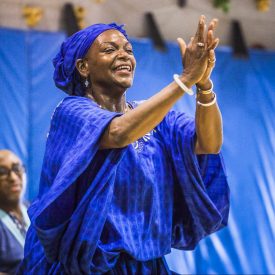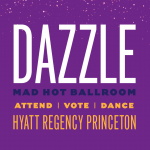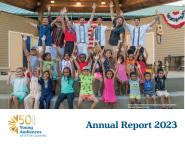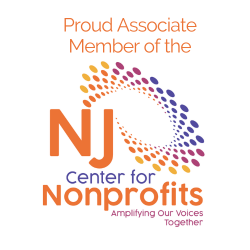#BlackHistory365 – It’s Not Just About February
It’s Not Just About February
By Michele Russo
As part of our ongoing growth as an organization, Young Audiences is reviewing our programming, our business practices, and our partnerships with educators and schools with a critical eye on diversity, equity, inclusion, and access.
In 2018 we adopted our Arts United Plan, a 3-year road map for integrating best practices into all aspects of Young Audiences. This work is grounded in the goal that all children participating in our programs are recognized and included.

YA Teaching Artist Jeannine Osayande performing at Ithan Elementary School in Bryn Mawr, PA.
No surprise, this work has revealed blind spots and unintended consequences of our actions. We recently received an email from YA Artist Jeannine Osayande of Dunya Performing Arts Company, that said, “I realize that Black History Month has an important purpose in carving out a time where schools stop to recognize Black history, but we need to do more. I am interested in opportunities that shatter the one-month BHM programming idea. We have no issue with performing in schools during Black History Month, however, I believe that we must educate folks to a new way of engaging with Black History in an everyday kind of way.”
Black History Month was created in 1970 as a step forward in recognizing the contributions of Black Americans in American history. Today the tradition is widely celebrated, but also presents questions that academics, educators, and writers are posing about maintaining Black History Month in its current state. At Young Audiences, we recognize the importance of Black History Month. We also see unintended consequences on students’ education. When Black history is relegated to one month of the year, do we unintentionally say that Black history is irrelevant the other 11 months of the year?
Additionally, many Black YA teaching artists work without pause throughout February, but their programs are requested less frequently in other months. A few years ago, YA Teaching Artist TAHIRA was scheduled to perform her “Freedom Stories” assembly, but there was a snow day on the performance date. In attempting to reschedule, TAHIRA offered the school March 1. The school decided to cancel the performance entirely because it would be performed outside of Black History Month. Students lost out on hearing an acclaimed storyteller tell stories of important figures in history—an experience which could have lasting impact on their understanding and knowledge.
YA Trustee and recently retired school principal Bobbie Panfili recalls needing to report how her school met its mandated requirement to acknowledge Black History Month, to celebrate Hispanic Heritage Month, and so on. Bobbie knew that compliance was not enough. Her student population was a diverse group: the racial and ethnic make-up of students was 52% Hispanic, 31% African American/Black, 10% White, 4% Multi-Racial, 2% Asian, and 1% Hawaiian Native/Pacific Islander. Students had immigrated from 37 different countries. Bobbie and her team understood that validating and recognizing students’ identities was critical to their personal growth, and that relegating any group to a single month could potentially be damaging to her students’ perceptions of themselves and understanding of the world.
As a school leader, Bobbie worked to incorporate learning about Black Americans, Hispanic heritage, and the many cultures of her own students throughout the school year. She called it her “It’s Not Just About February” campaign. Here are some of the purposeful ways this was accomplished:
- Hosting International Food nights throughout the year where all families were invited to bring in food from their culture, traditional clothing and other cultural artifacts or mementos to share with the school community.
- Morning announcements including short bios of important contributors to America who are Black and brown.
- Meeting with community organizations in the neighborhood—churches and community centers—to develop partnerships that met the community’s needs.
- Using her “robocalls” to families to remind them what activities were happening at school and what celebrations were occurring.
- Creating a “Holidays Around the World” event so all families could share their traditions and celebrations.
- Reviewing book selections in the school library to ensure that diverse stories were being told by diverse authors.
We are thinking through how YA can do better in this regard. In addition to Black History Month, other history and heritage months like Hispanic Heritage Month and Chinese New Year can result in similar unintended consequences. We are asking ourselves what we can do to break out of this compartmentalized way of teaching and learning about histories, narratives, and people. We’re looking at our program offerings and seeking ways to educate students about Black History beyond the already well-known figures and events that are typically discussed in school. And when talking with our school partners, we are opening up the discussion, and making suggestions for how to incorporate our programs throughout the school year.
We are encouraged that the New Jersey Amistad Curriculum is being supported in new ways through a partnership between the State of New Jersey Department of Education and the New Jersey Education Association. The curriculum is a starting point toward a more racially literate education system, which will then enable us to construct a more racially just world. We hope that similar efforts build in Pennsylvania.
We hope you’ll join us in this endeavor and consider how we can provide the most inclusive education to our students as possible. Do you have a best practice to share? We’d love to hear it. Connect with us via social media or call the office and speak to any staff person. We’ll be excited to hear from you.
We encourage you to share this blogpost and use #BlackHistory365 and #ArtsUnitedYA when posting on social media.
This blogpost was written in collaboration with YA’s Arts United Committee and with contributions from Bobbie Panfili, YA Trustee and former Principal at G.E. Wilson Elementary School in Hamilton, NJ.








